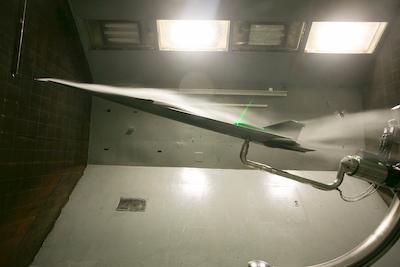Undergoes Wind Tunnel Testing At NASA Langley
It’s a long way from now until the year 2023 for researchers who hope their airplane will lead the next innovation of flight – which is just fine with aeronautics researcher Corey Diebler.

Diebler, who works in the Flight Dynamics Branch at NASA’s Langley Research Center in Hampton, Virginia, is the flight dynamics and simulation lead for the Low Boom Flight Demonstrator project. “With this particular test, we’re breaking new ground,” Diebler (pictured) said. “We’re going into a region where we don’t have any other data to guide us.”
NASA recently awarded Lockheed Martin Aeronautics Company a $247.5 million contract to build a faster-than-sound X-plane — with the official designation of X-59 Quiet SuperSonic Technology, or QueSST — that will demonstrate quiet supersonic technologies in straight and level flight over a large area.
Before the X-59 sees the skies, it must undergo many rounds of testing. The current set of tests, conducted in Langley’s 12-Foot, Low-Speed Tunnel, collected low-speed aerodynamic stability and control data from a sub-scale X-59 model to expand upon previous experimental and computational predictions. “This sort of testing gives you a real experimental grounding to see how it compares to the analytical methods,” Diebler said. “Being a flight test project, it’s always good to know what lies out there beyond the edges of our planned flight envelope and understand how the airplane will behave when it gets in those regions … should we find ourselves there.”
The wind tunnel data will be used to develop simulation models and refine vehicle flight controls, which will improve how the airplane flies, even at unlikely flight conditions. “This data will give us a better understanding of where we can fly safely.” Diebler said. “We’ll use this data in our simulations and it will improve our predictions as to how well the airplane handles over a wider range of flight conditions.”
The test consisted of three phases: static stability and control tests, dynamic forced oscillation tests, and flow visualization tests using some and laser techniques. The high angle of attack phase provided data at greater pitch angles than previous tested, which will improve the X-59 simulation at those conditions.
During forced oscillation tests, the X-59 model was put through roll, pitch, and yaw motions and the aerodynamic damping derivatives were measured. The damping derivatives are necessary to properly model the aircraft’s response to unsteady events such as in-flight turbulence. “When we’re doing the forced oscillation tests, we force the model to roll at a defined rate,” Diebler said. “We essentially extract how the aerodynamics resist that motion and hopefully dampen out the roll, pitch and yawing motions.”

Finally, during the third phase of the test, smoke and lasers were used to illuminate the airflow to understand how the vortices created by the wings and canards behave and how they interact with other parts of the airplane such as the vertical tail or the engine inlet. “This sort of testing gives you a real experimental grounding to see how it compares to the analytical methods,” Diebler said.
An added bonus, according to Diebler, is that tunnel testing is more interactive than sitting at a computer, which makes it a fun change of pace. “Testing a sub-scale model of the X-59 in our 12-Foot Tunnel is like tinkering in your garage due to the hands-on aspect,” Diebler said. “When you do a test like this, you really get a feel for the airplane, even though it’s a scaled model.”
Computational fluid dynamics, even with its complex calculations, is growing in use, but tunnel testing can complement any information learned from it. “In a wind tunnel, once the model has been made, you can collect enormous amounts of data very quickly,” Diebler said.
The X-59 QueSST is designed so that when flying supersonic, people on the ground will hear nothing more than a sonic thump – if anything at all. Lockheed Martin is scheduled to begin construction of the X-59 at its Skunk Works plant in Palmdale, California, in early 2019. Once fully tested and deemed safe to fly within the national airspace, the X-59 in 2023 will begin making supersonic flights over select communities to measure residents’ reactions to any noise they might hear.
The scientifically valid data gathered from these community overflights will be presented to U.S. and international regulators, who will use the information to help them come up with rules based on noise levels that enable new commercial markets for supersonic flight over land. Before that happens, more data needs to be acquired for the X-59 to get ready to fly.
“The data that we’re collecting is going to directly affect the vehicle flight controls and how well the airplane flies,” Diebler said. “This test is an important step that will allow us to continue to refine the controls and make improvements as we get closer to first flight.”
(Images provided with NASA news release)
 Unfortunate... ANN/SportPlane Resource Guide Adds To Cautionary Advisories
Unfortunate... ANN/SportPlane Resource Guide Adds To Cautionary Advisories ANN FAQ: Turn On Post Notifications
ANN FAQ: Turn On Post Notifications ANN's Daily Aero-Term (04.29.24): Visual Approach Slope Indicator (VASI)
ANN's Daily Aero-Term (04.29.24): Visual Approach Slope Indicator (VASI) ANN's Daily Aero-Term (04.28.24): Airport Marking Aids
ANN's Daily Aero-Term (04.28.24): Airport Marking Aids ANN's Daily Aero-Linx (04.28.24)
ANN's Daily Aero-Linx (04.28.24)




